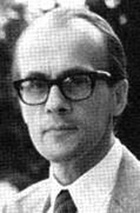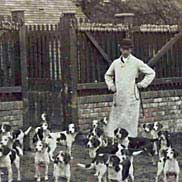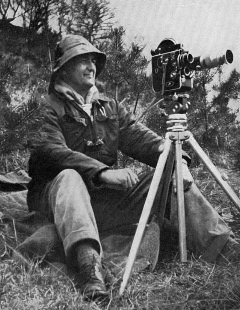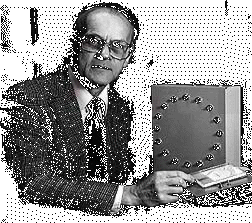Mind Scientist Helmut Schmidt Dies
Posted by: Loren Coleman on August 22nd, 2011

I have become aware of another Fortean death. A scientist who worked for the Tom Slick-founded Mind Science Foundation and Dinsdale Award winner has died.

Helmut Schmidt (February 21, 1928 – August 18, 2011) was a German-born parapsychologist. In the early 1970s, he pioneered research into the effects of human consciousness on machines called random number generators or random event generators at the Rhine Research Center Institute for Parapsychology. He was appointed Research Director of the Institute in 1969.

Schmidt’s early psychokinesis experiments involved machines with one red and one green light. Subjects would attempt to make one light illuminate more than another. Schmidt has reported success rates of 1–2% above what would be expected at random over a large number of trials. A metastudy that reviewed more than 800 such studies from 68 laboratories came to the conclusion that “under certain circumstances, consciousness can interact with random physical systems.”
In 1983, the journal Research in Parapsychology published a paper entitled “Superposition of PK Effects by Man and Dog” by Helmut Schmidt.

The design for the experiment was simple: a man performed a standard test of extra-sensory perception (ESP), attempting to guess what symbols were illustrated on a series of concealed cards, and a dog (a ‘supposedly non-psychic’ miniature dachshund) was rewarded with a chocolate every time the man guessed correctly. The dog was thus motivated to improve the man’s performance by psycho-kinetic (PK) means. The results showed that the man’s results did indeed improve, but the best results of all were obtained when the dog performed the ESP test on its own. The conclusion was that further research was needed.
Schmidt was a physicist who has specialized in parapsychology. He was born in Danzig, Germany, February 21, 1928. He was educated at the University of Göttingen (M.A., 1953) and the University of Cologne (Ph.D. Physics, 1958). He moved to North America in 1964 as a visiting lecturer at the University of British Columbia and stayed to become senior research physicist at Boeing Science Research Laboratory (1966-69) and a resident associate at the Institute of Parapsychology (1969-70). In 1970 he was named director of the institute, a position he held until 1973. In recent years, Schmidt became associated with The Mind Science Foundation in San Antonio, Texas, which was first founded by Tom Slick.

Schmidt was praised by critics of parapsychology as the person with the most sophisticated approach to the methodological design of parapsychological experiments. He conducted research with electronic random generators (with which he is most identified), and with E. H. Walker he proposed a “psi enhancement” paradigm in which it is suggested that psi faculty is triggered at the instant of positive feedback. He also worked with Walter J. Levy, Jr. on possible PK in chickens, cockroaches, and rats, though the studies with Levy were called into question after it was discovered that he had been manipulating data.
In 1992, Schmidt was awarded the Tim Dinsdale Award for ” Helmut Schmidt for pioneering electronic and computer techniques in the study of human-machine interactions.”

Tim Dinsdale (above), the adventurer and Loch Ness hunter, lives on in the Tim Dinsdale Memorial Award. The Dinsdale Award was established in 1992 by The Society for Scientific Exploration’s founding member, councilor, and editor of the SSE Journal, (now retired) Professor Henry Bauer, so that the SSE could recognize “significant contributions to the expansion of human understanding through the study of unexplained phenomena.”
Schmidt won the first award. William Corliss who recently died, won the second. And Robert Rines, who also recently passed away, won the award in 2004.

Some of Schmidt’s published works are,
Precognition of a Quantum Process. J. of Parapsychology 33, 1969, 99-108.
The PSI Quotient (PQ): An Efficiency Measure for PSI Tests. J. of Parapsychology 33, 1969, 210-214.
Clairvoyance Test with a Machine. J. of Parapsychology 33, 1969, 300-306.
Quantum Processes Predicted? New Scientist, October 1969, 114-115.
Quantum-Mechanical Random-Number Generator. J. of Applied Physics 41, 1970, 462-468.
A PK Test with Electronic Equipment. J. of Parapsychology 34, 1970, 175-181.
PK Experiments with Animals as Subjects. J. of Parapsychology 34, 1970, 225-261.
Mental Influence on Random Events. New Scientist and Science Journal, June 24, 1971, 757-768.
Schmidt, Helmut and Pantas, Lee. Psi Tests with Internally Different Machines. J. of Parapsychology 36, 1972, 222-232.
PK Tests with a High-Speed Random Number Generator. J. of Parapsychology 37, 1973, 105-118.
Instrumentation in the Parapsychology Laboratory. In Beloff, John: New Directions in Parapsychology, 1974, 13-37.
Psychokinesis. In Mitchell, Edgar. Psychic Explorations, 1974, 178-193.
Comparison of PK Action on Two Different Random Number Generators. J. of Parapsychology 38, 1974, 47-55.
Psi als Wechselwirkung zwischen geistigen Vorgängen und äusseren Quantenprozessen. Psi und Psyche (E. Bauer, Editor). Deutsche Verlagsanstalt Stuttgart, 1974, 187-195.
Toward a Mathematical Theory of Psi. J. Am. Soc. Psychical Research 69, 1975, 302-319.
PK Effect on Pre-Recorded Targets. J. Am. Soc. Psychical Research 70, 1976, 267-291.
A Suggested Method for Detecting Psi with Subjects whose Performance Fluctuates from Trial to Trial. J. Am. Soc. Psychical Research 71, 1977, 19-31.
A Simple Random Number Generator for Use with Mini-computers. J. Am. Soc. Psychical Research 71, 1977, 171-176.
Can an Effect Precede Its Cause? A Model of a Non-causal World. Foundations of Physics 8, June 1978, 463-480.
A Program for Channeling Psi Data into the Laboratory and onto the Critic’s Desk. Progress in Parapsychology 1979 (W. Roll, Editor), 66-69.
PK Tests with Pre-Recorded and Pre-Inspected Seed Numbers. J. of Parapsychology 45, 1981, 87-98.
Collapse of the State Vector and PK Effect. Foundation of Physics 12, 1982, 565-581.
Randomness and the Mind. Looking for Psychic Effect in Games of Chance. Creative Computing, April 1983, 180-186.
Comparison of a Teleological Model with a Quantum Collapse Model of Psi. J. of Parapsychology 48, 1984, 261-276.
Addition Effect for PK on Pre-recorded Targets. J. of Parapsychology 49, 1985, 229-244.
Schmidt, H. Morris, R. and Rudolph, L. Channeling Evidence for a Psychokinetic Effect to Independent Observers. J. of Parapsychology 50, 1986, 1-15.
The Strange Properties of Psychokinesis. J. Scientific Exploration 1, 1986, 103-118.
Correlation between Mental Processes and External Random Events. J. Scientific Exploration 4, 1990, 233-241.
Search for a Correlation between PK performance and Heart Rate. J. Amer. Soc. Psychical Research 85, 1991, 101-117.
Non Causality as the Earmark of Psi. Journal of Scientific Exploration 7, 1993, 125-132.
Schmidt, H. and Braud, W. New PK Tests with an Independent Observer. Journal of Parapsychology 57, 1993, 227-239.
Schmidt, H., Stapp, H. Study of PK with pre-recorded random events and the effect of pre-observation. Journal of Parapsychology 57, 1993, 331-348.
Schmidt, H. Observation of a psychokinetic effect under highly controlled conditions. Journal of Parapsychology 57, 1993, 351-372.
Schmidt, H. Random generators and living systems as targets in retro-PK experiments. J. Amer. Soc. Psychical Research 91, 1997,1-13.
Schmidt, H. and Dalton, K. PK tests with repeated efforts on prerecorded targets. Journal of Parapsychology 63, 1999, 275-283.
Schmidt, H. A proposed measure for psi-induced bunching of randomly spaced events. Journal of Parapsychology 64, 2000, 301-316.
The parapscyhologist is not to be confused with the German Social Democrat Helmut Schmidt (born 1918), who served as chancellor of the Federal Republic of Germany (West Germany) from 1974 to 1982.
About Loren Coleman
Loren Coleman is one of the world’s leading cryptozoologists, some say “the” leading living cryptozoologist. Certainly, he is acknowledged as the current living American researcher and writer who has most popularized cryptozoology in the late 20th and early 21st centuries.
Starting his fieldwork and investigations in 1960, after traveling and trekking extensively in pursuit of cryptozoological mysteries, Coleman began writing to share his experiences in 1969. An honorary member of Ivan T. Sanderson’s Society for the Investigation of the Unexplained in the 1970s, Coleman has been bestowed with similar honorary memberships of the North Idaho College Cryptozoology Club in 1983, and in subsequent years, that of the British Columbia Scientific Cryptozoology Club, CryptoSafari International, and other international organizations. He was also a Life Member and Benefactor of the International Society of Cryptozoology (now-defunct).
Loren Coleman’s daily blog, as a member of the Cryptomundo Team, served as an ongoing avenue of communication for the ever-growing body of cryptozoo news from 2005 through 2013. He returned as an infrequent contributor beginning Halloween week of 2015.
Coleman is the founder in 2003, and current director of the International Cryptozoology Museum in Portland, Maine.










Rest in peace to one of the first men to sincerely attempt to study ESP and the interactions between humans and their environmental stresses and cues. His work paved the way for a lot of future studies in psychology and math.
Although I do hope that blurb about feeding chocolate to dogs was misquoted. I’ve always heard chocolate is dangerous for most breeds.